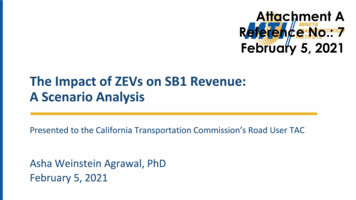
Transcription
Attachment AReference No.: 7February 5, 2021The Impact of ZEVs on SBl Revenue:A Scenario AnalysisPresented to the California Transportation Commission's Road User TACAsha Weinstein Agrawal, PhDFebruary 5, 2021
Fuel taxesGasoline excise taxBaseexciseof30 /gallon swap excise of 17.3 /gallon (effective 7/1/2019)Diesel excise tax36 per gallonDiesel swap sales tax5.75% on purchase priceVehicle fees (annual)Transportation Improvement Fee (TIF) 25 - 175; rate depends on vehicle valueRoad Improvement Fee (RIF) 100 per ZEV (effective 7/1/2020)
InputHighMediumLowAnnual stateVMTVMT increases linearly to reach 90% ofpre-COVID-10 levels by January 2021,increases linearly to predicted pre-COVID-19levels by January 2022, and increases linearlyto 120% of predicted levels based onpre-COVID-19 conditions by the end of 2040.VMT remains at August 2020 levels until April 2021,then increases linearly so to the predictedpre-COVID-19 level by April 2023, and remains atpredicted pre-COVID-19 VMT through 2040.VMT remains at August 2020 levels untilMarch 2025, increases linearly to reach 90%of pre-COVID-19 levels December 31, 2030,and remains at 90% of predictedpre-COVID-19 VMT through 2040Light-dutyvehicle fleet sizeLight-duty fleet increases by 1.9% annually(highest year-to-year growth rate during2008-2017)Light-duty fleet increases by 0.8% annually (meanyear-to-year growth rate from 2018-2019)Light-duty fleet size declines linearly to 0.66vehicles per person by 2040.Heavy-dutydiesel fleet sizeThe diesel % of heavy-duty fleet declineslogarithmically to 40% by 2030 and 0% by2034. After 2034, the heavy-duty fleet remains0% diesel.Diesel % of heavy-duty fleet declineslogarithmically to 55% by 2030 and 50% by 2040.The diesel % of the heavy-duty fleet followsEIA projections, reaching 73% in 2040.Light-duty ZEVfleet sizeThe number of light-duty ZEVs increases at anexponential rate so that they constitute 75% oflight-duty registered vehicles by 2040.Light-duty ZEV fleet size increases exponentiallysuch that the state of California reaches its goals of1.5 million ZEVs by 2025 & 5 million ZEVs by 2030.After 2030, the ZEV fleet grows 1 million per year.Light-duty ZEV fleet size increases by 94,112vehicles per year (the annual rate of growthfrom 2018-2019).Light-duty ZEVvehicle valuesZEV values start at EIA projections in 2020 andconverge linearly to EIA projections forlight-duty ICE vehicles by 2040.ZEV values start at EIA projections in 2020 andconverge linearly to EIA projections for light-dutyICE vehicles by 2035. After 2035, ZEV valuesfollow EIA projections for light duty-vehicles.ZEV values start at the EIA projections in2020, converge linearly to EIA projections forlight-duty ICE vehicles by 2030, and follow EIAprojections to 2040.
Light-dutyfleet sizeHeavy-dutydiesel fleetsizeLight-duty ZEVfleet sizeZEV MediumMediumMediumMediumMedium4. High VMT medium fleet high ZEVHighMediumLowHighLow5. Medium VMT large fleet high te VMT1. High-carbon: high VMT large fleet low ZEV2. High VMT large fleet high ZEVScenarios3. All medium6. Low carbon: low VMT small fleet high ZEVNote: See table on earlier slide for definitions of the high, medium, and low trajectories for each input.
Light-duty ZEV fleet size increases exponentially such that the state of California reaches its goals of 1.5 million ZEVs by 2025 & 5 million ZEVs by 2030. After 2030, the ZEV fleet grows 1 million per year. Light-duty ZEV fleet size increases by 94,112 vehicles per year (the annual rate of growth from 2018-2019). Light-duty ZEV vehicle values










